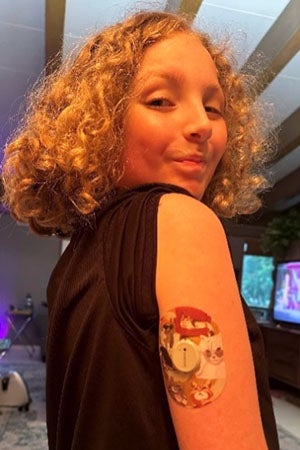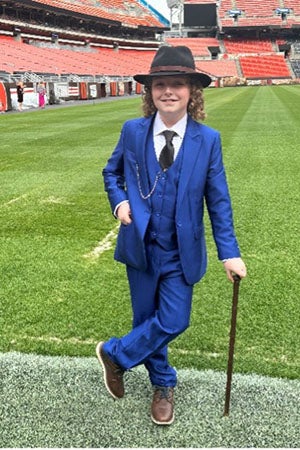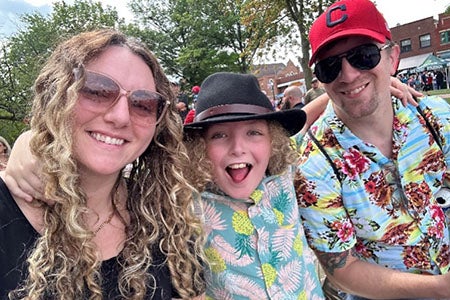HR Community Feature: A family’s unexpected journey with Type 1 Diabetes
May 28, 2024
Hey everyone, I’m Jasmine Shadburn, a Solutions Architect on the HRISS team living in Ohio. This is the story of my son Gianni and our unexpected journey with Type 1 Diabetes.
 Last summer was a hot one and Gianni was drinking a ton of water, getting taller, thinner, and seemed more tired than normal. I attributed these changes to normal adolescent growth since he was going into Middle School in the fall.
Last summer was a hot one and Gianni was drinking a ton of water, getting taller, thinner, and seemed more tired than normal. I attributed these changes to normal adolescent growth since he was going into Middle School in the fall.
Everything seemed fine until, suddenly, it wasn’t. Gianni’s breathing became labored—as if he’d just run a marathon, even though he was merely sitting down. That’s when I knew something was wrong.
We rushed to a local children’s hospital, and the urgency with which the ER staff acted told me this was serious. “You really don’t know what’s going on with him?” the doctor asked, looking at me with a mix of disbelief and concern. I stood there, frozen in fear. She said, “He has diabetes.” My heart sank. Diabetes? What? How? Are you sure? They were sure. The tests confirmed it.
We spent the next five days in the ICU because he was in diabetic ketoacidosis, a potentially life-threatening complication of diabetes. I kept asking myself: how I could have missed the signs? Type 1 can be tricky to spot, but here are some common warning signs to watch for:
- excessive thirst
- excessive urination
- bed wetting
- fatigue
- unexplained weight loss
- blurred vision
If you notice any of these symptoms in your child, I encourage you to immediately speak to their health care provider and advocate to get them tested for Type 1 Diabetes.
What exactly is Type 1 Diabetes?
It’s an autoimmune disease that happens when the body attacks itself by mistake, destroying the insulin-producing cells in the pancreas. This means lab-made insulin needs to be taken for life, several times a day through an injection or pump. People with this disease can experience dangerously high or blood sugar that can be life-threatening. Managing it requires constant attention and action- including overnight.
The reality of Gianni’s diagnosis hit me hard. How could this be happening to him? He has to get insulin injections before he eats anything? FOREVER? I didn’t want this to be reality, but it was. Our family rallied around Gianni as we learned how to manage his diabetes. The Akron Children’s Hospital did a phenomenal job educating us and trying to prepare us for what life would look like moving forward. Also, shoutout to The Ronald McDonald house for their mission and everything they do. Without them providing us with housing and meals for the week, I may have missed out on important education regarding his new diagnosis.
In the midst of all of this, I can’t forget how supportive my colleagues were here at Yale. I unexpectedly had to miss work while going through the worst week of my life, and I never felt pressure from my managers; only love and support. This meant so much and I am grateful for the initial and ongoing support as we navigate this journey.
It makes me want to show up for people in similar situations, and that is why I wanted to share my story. Hearing other people’s stories can help us become more understanding and compassionate. By sharing our experiences, we can create a supportive community and learn from one another.
I had no idea what life was like for a Type 1 Diabetic. Now I realize that they have so much on their plates just trying to live day to day that sometimes just listening, acknowledging their exhaustion, and sending encouragement can do a world of good. And to their caregivers just the same. It’s ok to be overwhelmed, and it’s ok to cry. You’re doing a great job.
 Life post diagnosis has been a rollercoaster. As if going to middle school wasn’t scary enough, Gianni had to start school two weeks after his diagnosis. He was overwhelmed and embarrassed because he didn’t want people to know about his diabetes. He would always wear a coat to cover his Dexcom Monitor, and he didn’t want to carry supplies with him for fear someone would notice.
Life post diagnosis has been a rollercoaster. As if going to middle school wasn’t scary enough, Gianni had to start school two weeks after his diagnosis. He was overwhelmed and embarrassed because he didn’t want people to know about his diabetes. He would always wear a coat to cover his Dexcom Monitor, and he didn’t want to carry supplies with him for fear someone would notice.
Over the past 9 months, I have watched him become a stronger, smarter, and unbelievably capable young man. He has learned to listen to his body, he’s carb counting, giving his own insulin shots, and learning to use new technology to manage his daily life. He’s becoming more empowered by the day. Although living with Type 1 is tough, he is tougher.
We recently attended our first fundraising event through JDRF, the Juvenile Diabetes Research Foundation. It was AMAZING to be surrounded by people who come together to cure, prevent, and treat this disease. In October, we are doing the JDRF One Walk. If you would like to walk with us or donate to finding a cure, check out our page.
 Our journey has just begun, but with the support of the Type 1 community and awareness, we are hopeful for a bright future. Thank you for reading our story and for your support.
Our journey has just begun, but with the support of the Type 1 community and awareness, we are hopeful for a bright future. Thank you for reading our story and for your support.


